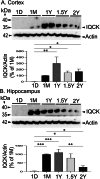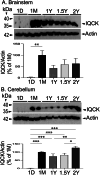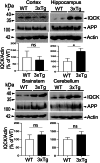Robust Increase in IQCK Protein Expression in Mouse Models of Alzheimer's Disease and iPSC-Derived Neurons
- PMID: 40604342
- PMCID: PMC12221807
- DOI: 10.1111/jcmm.70686
Robust Increase in IQCK Protein Expression in Mouse Models of Alzheimer's Disease and iPSC-Derived Neurons
Abstract
Emerging studies indicate that the IQ-motif-containing protein K (IQCK) is a novel risk factor for Alzheimer's disease (AD), an age-associated disease. The expression patterns of IQCK in healthy and AD brains, within the context of age and sex are largely unknown. Therefore, we compared the age-dependent expression patterns of IQCK in males and females of wild-type (WT) mice with AD-like 3xTg and APΔE9 mice. Additionally, we measured IQCK protein expression in AD-derived human iPSC neurons. In WT mice, we found no IQCK expression at day 1 (1D) in the cortex (CX), hippocampus (HP), brainstem (BS) and cerebellum (CB). Overall, IQCK protein expression in different brain regions was first detected in 1-month-old wild-type (WT) mice, reaching its maximum in 1-year-old mice (1Y), and then gradually decreased in 2-year-old mice. In the APΔE9 mice, IQCK protein levels significantly increased by 1246% in the CX, 682% in the HP and 169% in the BS relative to WT controls. In the 3xTg mice, only HP showed an increase of IQCK protein by 277%. In addition, we also detected elevated tendencies in BS and CB regions but not in the CX. Finally, IQCK expression was also significantly increased by 68% in the AD-derived iPSC neurons relative to the NC-derived iPSC neurons. Thus, increased IQCK protein levels in the brain of AD-like 3xTg and APΔE9 mouse models suggest a possible role in AD pathogenesis, a finding that requires further clarification.
Keywords: 3xTg mice; APΔE9 mice; Aging; Alzheimer's disease; Brain regions; Dendrites; IQCK; iPSC neurons.
© 2025 The Author(s). Journal of Cellular and Molecular Medicine published by Foundation for Cellular and Molecular Medicine and John Wiley & Sons Ltd.
Conflict of interest statement
The authors declare no conflicts of interest.
Figures






References
-
- Moss M. B., Killiany R. J., Lai Z. C., Rosene D. L., and Herndon J. G., “Recognition Memory Span in Rhesus Monkeys of Advanced Age,” Neurobiology of Aging 18, no. 1 (1997): 13–19. - PubMed
-
- Herndon J. G., Moss M. B., Rosene D. L., and Killiany R. J., “Patterns of Cognitive Decline in Aged Rhesus Monkeys,” Behavioural Brain Research 87, no. 1 (1997): 25–34. - PubMed
-
- Goldberg A. L., “Protein Degradation and Protection Against Misfolded or Damaged Proteins,” Nature 426, no. 6968 (2003): 895–899. - PubMed
-
- Ohsumi Y., “Protein Turnover,” IUBMB Life 58, no. 5–6 (2006): 363–369. - PubMed
-
- Vilchez D., Saez I., and Dillin A., “The Role of Protein Clearance Mechanisms in Organismal Ageing and Age‐Related Diseases,” Nature Communications 5 (2014): 5659. - PubMed
MeSH terms
Grants and funding
LinkOut - more resources
Full Text Sources
Medical
Molecular Biology Databases
Research Materials
Miscellaneous

